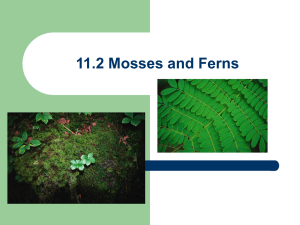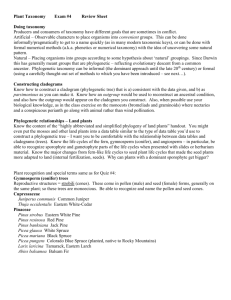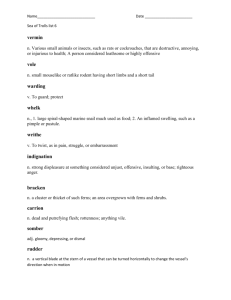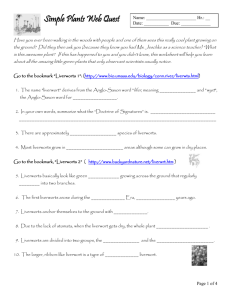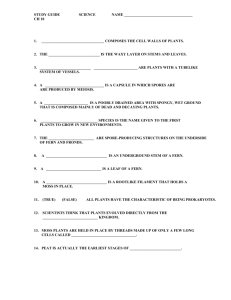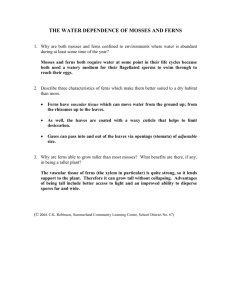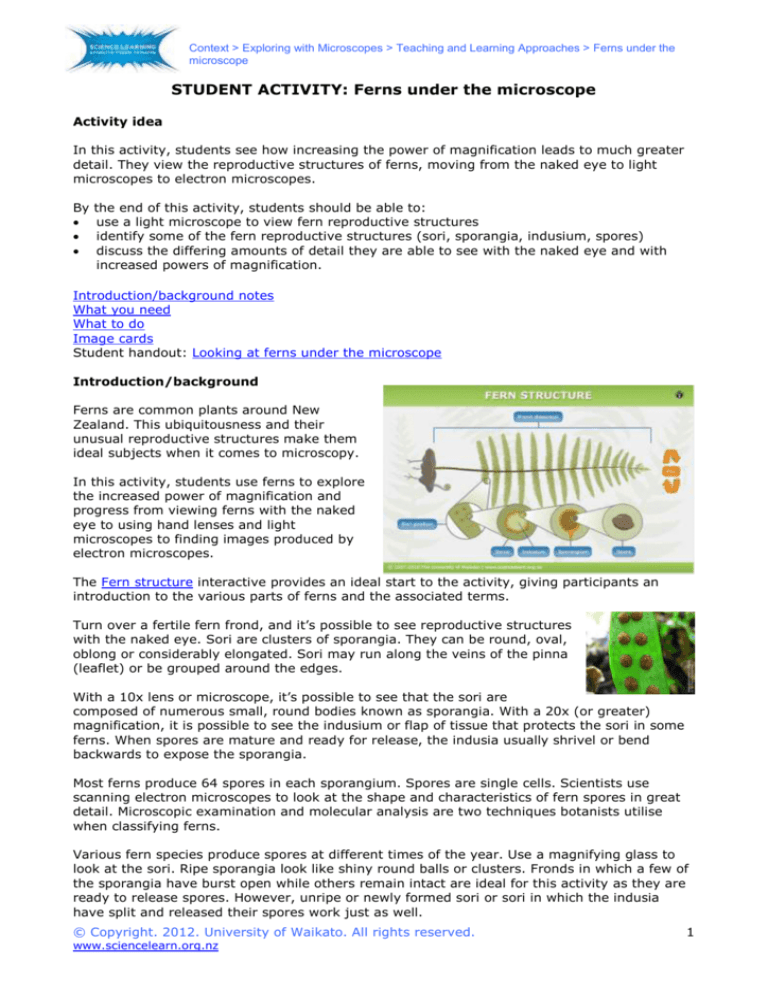
Context > Exploring with Microscopes > Teaching and Learning Approaches > Ferns under the
microscope
STUDENT ACTIVITY: Ferns under the microscope
Activity idea
In this activity, students see how increasing the power of magnification leads to much greater
detail. They view the reproductive structures of ferns, moving from the naked eye to light
microscopes to electron microscopes.
By
the end of this activity, students should be able to:
use a light microscope to view fern reproductive structures
identify some of the fern reproductive structures (sori, sporangia, indusium, spores)
discuss the differing amounts of detail they are able to see with the naked eye and with
increased powers of magnification.
Introduction/background notes
What you need
What to do
Image cards
Student handout: Looking at ferns under the microscope
Introduction/background
Ferns are common plants around New
Zealand. This ubiquitousness and their
unusual reproductive structures make them
ideal subjects when it comes to microscopy.
In this activity, students use ferns to explore
the increased power of magnification and
progress from viewing ferns with the naked
eye to using hand lenses and light
microscopes to finding images produced by
electron microscopes.
The Fern structure interactive provides an ideal start to the activity, giving participants an
introduction to the various parts of ferns and the associated terms.
Turn over a fertile fern frond, and it’s possible to see reproductive structures
with the naked eye. Sori are clusters of sporangia. They can be round, oval,
oblong or considerably elongated. Sori may run along the veins of the pinna
(leaflet) or be grouped around the edges.
With a 10x lens or microscope, it’s possible to see that the sori are
composed of numerous small, round bodies known as sporangia. With a 20x (or greater)
magnification, it is possible to see the indusium or flap of tissue that protects the sori in some
ferns. When spores are mature and ready for release, the indusia usually shrivel or bend
backwards to expose the sporangia.
Most ferns produce 64 spores in each sporangium. Spores are single cells. Scientists use
scanning electron microscopes to look at the shape and characteristics of fern spores in great
detail. Microscopic examination and molecular analysis are two techniques botanists utilise
when classifying ferns.
Various fern species produce spores at different times of the year. Use a magnifying glass to
look at the sori. Ripe sporangia look like shiny round balls or clusters. Fronds in which a few of
the sporangia have burst open while others remain intact are ideal for this activity as they are
ready to release spores. However, unripe or newly formed sori or sori in which the indusia
have split and released their spores work just as well.
© Copyright. 2012. University of Waikato. All rights reserved.
www.sciencelearn.org.nz
1
Context > Exploring with Microscopes > Teaching and Learning Approaches > Ferns under the
microscope
What you need
Fertile fern fronds (those with sori on the underside)
Several sheets of white A4 paper
Magnifying glasses
Light microscopes
Access to the Looking Closer article Molecular analysis of ferns
Access to the Fern structure interactive
Access to YouTube clip showing fern spores being catapulted from sporangia
Access to the online Australasian Pollen and Spore Atlas
Copies of the fern image cards
Copies of the student handout Looking at ferns under the microscope
What to do
Preparation before the activity
1. Collect a variety of fertile fern fronds. Various fern species become fertile at different times
of the year. Identify fertile fronds by turning over individual fronds to see if the underside
is covered in sori. These reproductive structures are clearly visible and easy to spot. If the
fern fronds are large, simply collect a number of the leaflets (pinnae). If possible, try to
collect several different species. Alternatively, students can bring fertile fern fronds from
home on the day of the activity.
2. Lay the ferns on sheets of white A4 paper. Label each fern with its
species name if known. Cover with a second sheet of paper, a heavy
book and press overnight. This flattens the leaflets, making them easier
to use. It also identifies which ferns are ready to drop their spores. Ferns
that contain ripe sporangia will leave a spore print on the paper. Gather
any spores left on the paper. If there is no print or it is very faint, the
sporangia are either too early in their development or have released their
spores. (If the spores have been released, you can often see the split
indusium under the microscope.)
During the activity
3. Introduce the activity with the article Molecular analysis of ferns. Briefly discuss how
technology has changed the way in which organisms are classified – from using observable
features like reproductive structures to using a scanning electron microscope.
4. Give students time to work through the Fern structure interactive. Discuss the related
vocabulary and the relationships between the various reproductive structures of sorus,
indusium, sporangium and spore.
5. View the YouTube clip by Martin Microscope Company showing fern spores being catapulted
from the sporangium. The video was filmed using a stereomicroscope. (An extended
version of the clip displays several sori patterns and discusses the indusium.)
6. Look at the image cards. Discuss the sori position. (Along the veins or grouped around the
edges.) Discuss the sori shape. (Round, oval, oblong or elongated.)
7. Pass out the individual fern pinnae and give students time to view them with the naked
eye, hand lenses and light microscopes at various magnifications. Distribute copies of the
two-page student handout Looking at ferns under the microscope and ask students to
complete it as they work their way through the fern species.
© Copyright. 2012. University of Waikato. All rights reserved.
www.sciencelearn.org.nz
2
Context > Exploring with Microscopes > Teaching and Learning Approaches > Ferns under the
microscope
8. Students can use a light microscope to view fern spores. However, given that most spores
are around 20 microns in length, to get any useable characteristics may require more
powerful microscopes than those found in most schools. An internet search may reveal
individual spore images. The Australasian Pollen and Spore Atlas has a New Zealand
section with a few photos.
© Copyright. 2012. University of Waikato. All rights reserved.
www.sciencelearn.org.nz
3
Context > Exploring with Microscopes > Teaching and Learning Approaches > Ferns under the
microscope
Image cards
© Copyright. 2012. University of Waikato. All rights reserved.
www.sciencelearn.org.nz
4
Context > Exploring with Microscopes > Teaching and Learning Approaches > Ferns under the
microscope
© Copyright. 2012. University of Waikato. All rights reserved.
www.sciencelearn.org.nz
5
Context > Exploring with Microscopes > Teaching and Learning Approaches > Ferns under the microscope
Student handout: Looking at ferns under the microscope
How much extra detail can you see as you move through the powers of magnification?
Tick the reproductive structures you can clearly see with the various tools. Extra points for adding a drawing or description.
Sori position
Sori shape
Indusium
Sporangium
Spore
Eyes
Magnifying glass
Light microscope
© Copyright. 2012. University of Waikato. All rights reserved.
www.sciencelearn.org.nz
1
Context > Exploring with Microscopes > Teaching and Learning Approaches > Ferns under the microscope
Fill in this table as you use both your eyes and a light microscope to examine each fern species. Use the internet to find spore images.
Fern species
(Use common name or
attach the leaflet)
What is the
sori position?
What is the
sori shape?
© Copyright. 2012. University of Waikato. All rights reserved.
www.sciencelearn.org.nz
Indusium
(Tick)
Yes
No
Intact
Sporangium
(Tick)
Burst
Intact
Burst
Spores
From the fern?
(Tick)
Yes
No
Internet image?
(Tick)
Yes
No
2

